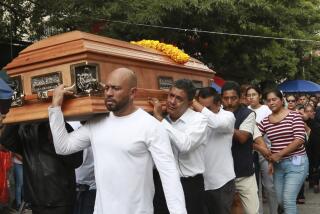‘Plan Colombia’ Leads the U.S. Into the Heart of Darkness
- Share via
There is a famous passage in Joseph Conrad’s “Heart of Darkness,” written in 1899, in which Marlow, the protagonist, comes upon “a man-of-war anchored off the coast” of North Africa, firing into the jungle. He describes the scene: “There wasn’t even a shed there, and [the man-of-war] was shelling the bush. It appears the French had one of their wars going on thereabouts.... In the empty immensity of earth, sky, and water, there she was, incomprehensible, firing into a continent.”
Conrad shows the absurdity of elaborate military technology when faced with a dispersed, populous and poorly identified enemy.
“There was a touch of insanity in the proceeding,” he concludes.
Last month, U.S. and Colombian officials celebrated the opening of a new base for the surveillance of drug trafficking in Colombia.
The Associated Press described the celebration: “U.S. and Colombian officials ... were treated to a loud demonstration of the kind of firepower Washington is providing under a $1.3-billion aid package.
“Patrol boats bristling with machine guns and grenade launchers zipped in formations along the muddy Orteguaza River, blasting away at the jungle on the opposite bank.
“Helicopters and warplanes shredded the jungle with bombs, rockets and machine guns.”
A Catholic priest was brought in to bless the radar station.
Apparently no one pointed out the event’s literary predecessor or remarked on its absurdity.
The $13-million surveillance facility was built with U.S. funds as part of “Plan Colombia,” a sweeping U.S.-sponsored program is intended to wipe out Colombia’s production of coca and heroin poppy.
As with Conrad’s man-of-war, the pomp and bombast of this display of modern firepower revealed only a basic futility.
Advanced military technology can decimate a jungle, but what can it do to achieve Plan Colombia’s stated goal of ending the supply of drugs?
More than 200,000 acres of drug crops have been destroyed by aerial application of herbicides so far this year, yet coca and heroin poppy production has increased. The targets of Plan Colombia are fields of drug crops.
Just like the unseen targets of the man-of-war in “Heart of Darkness,” these crops make for a dispersed, populous and poorly identified “enemy.”
Every time a field is destroyed by herbicides dropped from U.S. planes flown by U.S. pilots, another field is planted somewhere else.
Why? Because supply responds to demand.
The war on drugs hit Peru and Bolivia before it arrived in Colombia.
U.S. narcotics officials regularly boast of the successes of these campaigns, but the numbers tell a different story.
Coca production in Peru dropped by 203,000 acres between 1990 and 2000 as a result of aggressive eradication efforts and militarization. During the same 10-year period, coca production in Colombia rose 204,000 acres.
If and when eradication and militarization lead to a decrease in drug production in Colombia, drug crops surely will begin to be produced somewhere else.
The effects of this policy are tragic.
Legal crops grown near targeted drug crops are destroyed by the herbicide-spraying missions, leaving thousands of Colombians without income or nourishment.
Fish die, and livestock become sick from herbicide exposure.
Children develop rashes and eye infections.
Amazon forest is destroyed as farmers move to increasingly remote areas in an attempt to evade the sprayings.
Military funding--which makes up more than 70% of Plan Colombia--supports an armed force that is notorious for its cooperation with right-wing paramilitaries, which kidnap and kill hundreds of civilians each year.
Still, U.S. and Colombian officials act triumphant.
“We are winning this war,” exclaimed Brig. Gen. Mario Montoya, commander of Colombia’s southern forces, at the surveillance base dedication.
His optimism rings hollow: Until we in the United States are willing to acknowledge where the source of the drug problem actually lies--here at home, in a culture that produces extraordinary levels of drug abuse--how can we hope to do anything but show off our muscle, ceremonially obliterate some jungle now and then and endanger the lives of impoverished farmers whom we mistake for “the enemy”?
There is indeed “a touch of insanity in the proceeding.”
*
Phillip Cryan will travel to Colombia in January as part of a delegation from Witness for Peace, a human rights group based in Washington, D.C.
More to Read
Sign up for Essential California
The most important California stories and recommendations in your inbox every morning.
You may occasionally receive promotional content from the Los Angeles Times.













